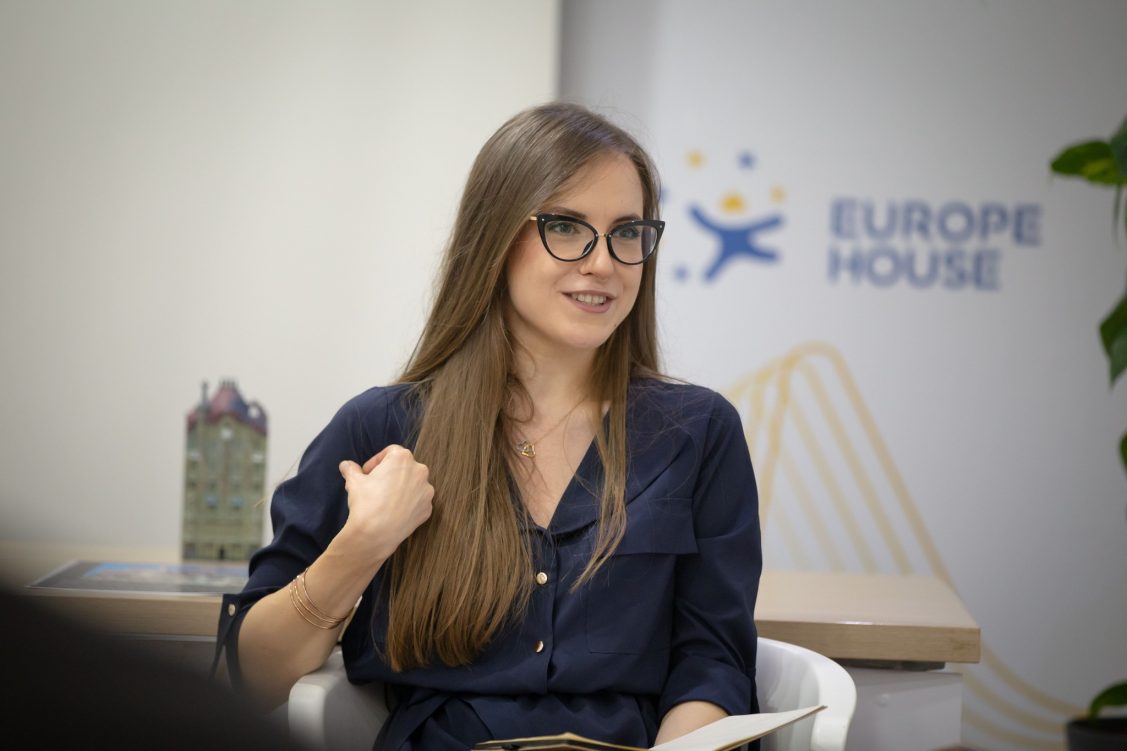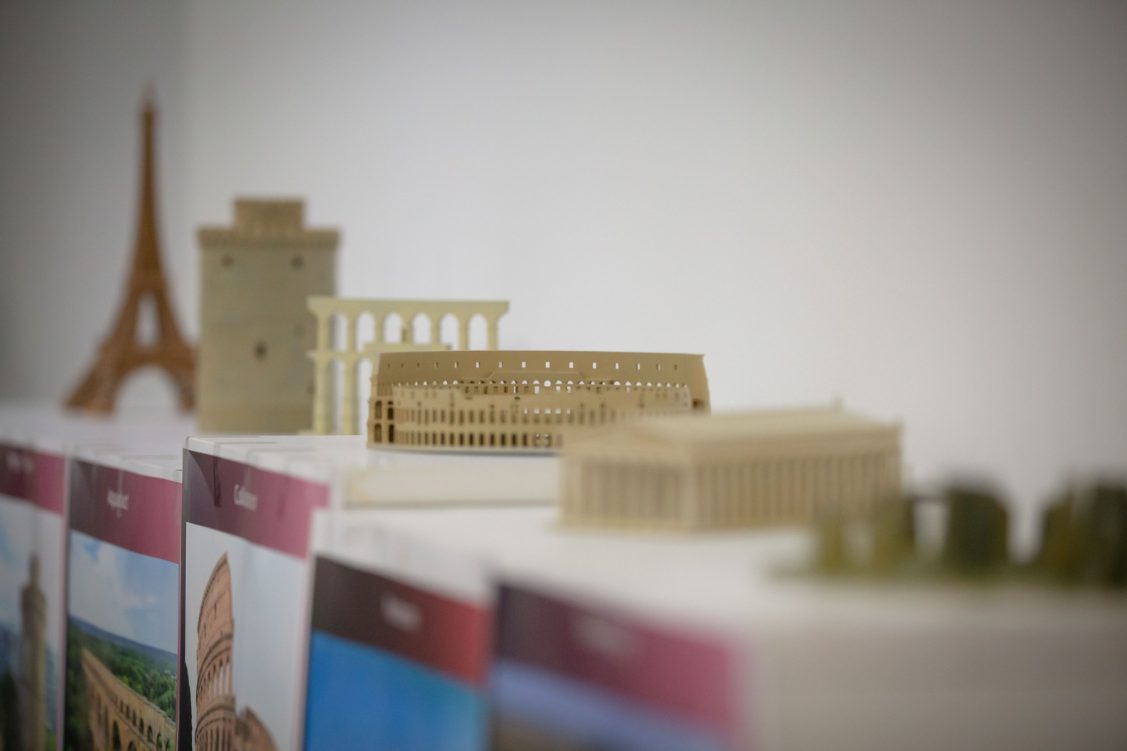November 9, 2023 | Thursday
An Interview with Natasa Hrnic
In September 2023, Natasa Hrnic, an architect and artist, opened her exhibition European Architecture Through Centuries at Europe House Mitrovica North.
Out of resin based on corn starch, she built 3D models of some of the most iconic European buildings over the centuries, in an effort to not only offer a glimpse of how architecture is a proof of human development, but also promote environmental awareness through the arts. In the interview below, she unfolds more details about her work and what inspired this exhibition.

What inspired your exhibition and how does it relate to your artistic journey?
More than a year ago I started exploring possibilities of 3D printing and eventually it became my big passion. As someone who is a huge fan of traveling and also an architect, I was fascinated by the old buildings of the old continent, especially because I had the opportunity to see them up close. At some point the idea of combining my two biggest passions – architecture and traveling, was born, and I have decided to start creating models of the most impressive buildings in Europe that I have had the opportunity to visit and that had a strong impact on me as an architect, traveler and artist.
Can you tell us about your creative process and the techniques you used to create the artworks in this exhibition?
At the beginning, I started working on models of the most famous buildings from some quite ordinary materials characteristic for 3D printing, and processing the drawings in the programs provided for that. This way I wanted to represent all recognizable European buildings, important for the development of human civilization in this part of the world, in a chronological order. That’s when I decided to start from the very beginning and made Stonehenge, as one of the oldest constructions. After Stonehenge everything just unfolded naturally, telling the story of human development.
How do you choose the materials and mediums for your artwork, and how do they contribute to the overall message of the exhibition?
After some time I discovered resin based on corn starch, which fascinated me because it was biodegradable, unlike other 3D printing materials, and I decided that next buildings would be made of the same material. Creating eco-friendly models was extremely important to me, because of the whole environmental and climate crisis. Architects are facing many challenges while projecting nowadays in terms of energy efficiency, so that was on my mind all the time while making exhibition models. Each one of the buildings represents a testimony of civilization development, and that was the main idea of this exhibition. In my opinion, architecture is one of the biggest and most important indicators of human development.

Can you tell us more about the social and historical context that informed your exhibition?
Through the way of building, materials and style we can exactly see how our ancestors were thinking and progressing. That deeply amazed me, and made me think about where civilization started, where it is today, and where it could be in a few decades or centuries. That’s exactly why this exhibition starts in some way with Stonehenge and ends with a modern building such as Turning Torso as a representative of modern architecture. It is truly amazing what we have achieved as a civilization so far.
What is the message of your artwork in this exhibition? Who do you address through your artwork and what kind of social debate do you intend to foster through your exhibition?
With this exhibition I wanted to encourage all the visitors to think about the progress of civilization and the development of architectural creativity and construction. I am aware that people in Kosovo don’t travel as much as they would love to, so it was important for me to present these objects, at least like this, in small format, and most of the visitors were thrilled. Also, corn starch based resin is a very important part of this exhibition. I wanted to point out how important our environment is, and to tell artists that even art should be environmentally conscious. We all should take care of our planet in any possible way that we can.
Are there any specific artists, movements, or art historical references that influence your artworks?
At this moment I am fascinated by the development of architecture, usage of materials, noticing how different styles were born and what was the impact of history on the development of human civilization. I find it very interesting and inspiring. That might be the subject of my future work. There are many artists who use 3D printing for their art. I love the work of Nick Ervinck, Belgian artist who pushes the limits of 3D printing. Also, I would mention Czech artist Monika Horcicova, who is extremely creative in her artistic work.
Is there any piece within the exhibition artworks that holds a special place for you and if so, why?
One thing that was in my mind while making building models for this exhibition was to make old buildings as they were before they were damaged, such as the Parthenon or Colosseum. Honestly speaking, old buildings were my favorite ones, especially because I put an effort in making them the way they were just after they were finished. Casa Batllo was also very interesting, because of the new painting techniques I was using on it.
You engaged in a talk with the audience about your exhibition in Europe House Mitrovica North. What were the most interesting remarks from the audience? How did they receive your exhibition?
This exhibition was remarkably and surprisingly well accepted and visited beyond my expectations. Audience members had many questions about the resin I was using for 3D printing. They were thrilled by the idea of it being eco-friendly, there were many jokes on how they look so good and they are even edible, which they are not, of course. What pleasantly surprised me were students of architecture. They loved the idea of 3D printing building models, which can be very helpful for those studying architecture. There were a number of young people who were interested in studying architecture after visiting this exhibition and that made me very happy and proud.
Will the feedback you got from the audience inform your upcoming works?
What I found very important was the interest of the audience in 3D printing and architecture. This experience inspired me to keep working with corn starch based resin in 3D printing and contribute to saving the environment in my own way because it is very important for me, and to start exploring with my own shapes and forms that could be practically used in architecture, or have artistic significance.
Why is your art important for the society? What kind of goals do you intend to achieve through your art?
In my opinion, this exhibition was a way to encourage the audience to think more deeply of themselves individually, of society, civilization, time and our impact on the environment and human development. I think I will keep that idea for some time, for my future work. It is my wish to get people closer to architecture, especially young people who are thinking of studying architecture, but feel insecure for some reason. Also, another very important thing that I want to point out is protection of the environment. My message for all the people, exhibition visitors, artists, architects, would be to take care of our planet Earth in every way possible. Each one of us is responsible. Protection of our planet starts with us.